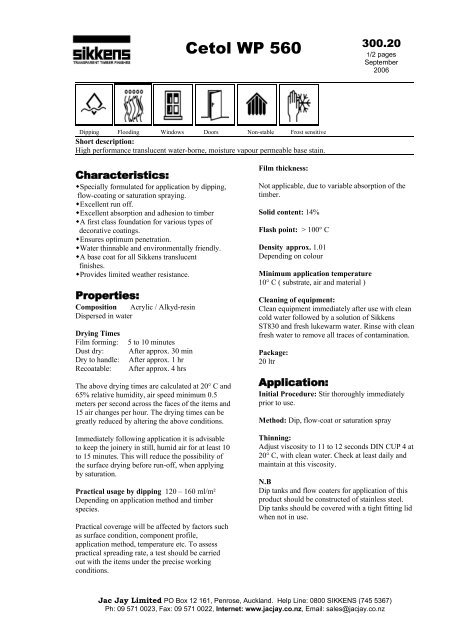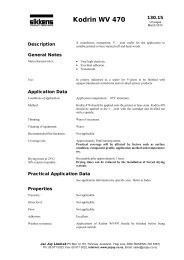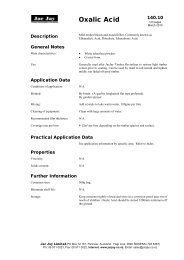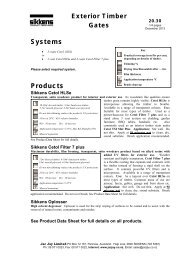Cetol WP 560 - Jac Jay Ltd
Cetol WP 560 - Jac Jay Ltd
Cetol WP 560 - Jac Jay Ltd
Create successful ePaper yourself
Turn your PDF publications into a flip-book with our unique Google optimized e-Paper software.
<strong>Cetol</strong> <strong>WP</strong> <strong>560</strong><br />
300.20<br />
1/2 pages<br />
September<br />
2006<br />
Dipping Flooding Windows Doors Non-stable Frost sensitive<br />
Short description:<br />
High performance translucent water-borne, moisture vapour permeable base stain.<br />
Characteristics:<br />
Specially formulated for application by dipping,<br />
flow-coating or saturation spraying.<br />
Excellent run off.<br />
Excellent absorption and adhesion to timber<br />
A first class foundation for various types of<br />
decorative coatings.<br />
Ensures optimum penetration.<br />
Water thinnable and environmentally friendly.<br />
A base coat for all Sikkens translucent<br />
finishes.<br />
Provides limited weather resistance.<br />
Properties:<br />
Composition Acrylic / Alkyd-resin<br />
Dispersed in water<br />
Drying Times<br />
Film forming:<br />
Dust dry:<br />
Dry to handle:<br />
Recoatable:<br />
5 to 10 minutes<br />
After approx. 30 min<br />
After approx. 1 hr<br />
After approx. 4 hrs<br />
The above drying times are calculated at 20° C and<br />
65% relative humidity, air speed minimum 0.5<br />
meters per second across the faces of the items and<br />
15 air changes per hour. The drying times can be<br />
greatly reduced by altering the above conditions.<br />
Immediately following application it is advisable<br />
to keep the joinery in still, humid air for at least 10<br />
to 15 minutes. This will reduce the possibility of<br />
the surface drying before run-off, when applying<br />
by saturation.<br />
Practical usage by dipping 120 – 160 ml/m²<br />
Depending on application method and timber<br />
species.<br />
Practical coverage will be affected by factors such<br />
as surface condition, component profile,<br />
application method, temperature etc. To assess<br />
practical spreading rate, a test should be carried<br />
out with the items under the precise working<br />
conditions.<br />
Film thickness:<br />
Not applicable, due to variable absorption of the<br />
timber.<br />
Solid content: 14%<br />
Flash point: > 100° C<br />
Density approx. 1.01<br />
Depending on colour<br />
Minimum application temperature<br />
10° C ( substrate, air and material )<br />
Cleaning of equipment:<br />
Clean equipment immediately after use with clean<br />
cold water followed by a solution of Sikkens<br />
ST830 and fresh lukewarm water. Rinse with clean<br />
fresh water to remove all traces of contamination.<br />
Package:<br />
20 ltr<br />
Application:<br />
Initial Procedure: Stir thoroughly immediately<br />
prior to use.<br />
Method: Dip, flow-coat or saturation spray<br />
Thinning:<br />
Adjust viscosity to 11 to 12 seconds DIN CUP 4 at<br />
20° C, with clean water. Check at least daily and<br />
maintain at this viscosity.<br />
N.B<br />
Dip tanks and flow coaters for application of this<br />
product should be constructed of stainless steel.<br />
Dip tanks should be covered with a tight fitting lid<br />
when not in use.<br />
<strong>Jac</strong> <strong>Jay</strong> Limited PO Box 12 161, Penrose, Auckland. Help Line: 0800 SIKKENS (745 5367)<br />
Ph: 09 571 0023, Fax: 09 571 0022, Internet: www.jacjay.co.nz, Email: sales@jacjay.co.nz
<strong>Cetol</strong> <strong>WP</strong> <strong>560</strong><br />
300.20<br />
2/2 pages<br />
September<br />
2006<br />
Processing notes<br />
Basic rules<br />
The wood moisture when using Sikkens systems<br />
should be between 11 % and 15 %.<br />
Paint systems for joinery<br />
1. Fully finished, stable wood frames<br />
Primer<br />
Sikkens <strong>Cetol</strong> <strong>WP</strong> <strong>560</strong><br />
Midcoat<br />
Sikkens <strong>Cetol</strong> WF 950<br />
Finish<br />
Sikkens <strong>Cetol</strong> WF 950<br />
2. Semi-stable and unstable wooden elements.<br />
If coating semi stable elements be aware of greater<br />
swelling and shrinkage due to moisture. This type<br />
of element must be coated in a thin build system.<br />
The dry film thickness should not exceed 40µm<br />
with unstable and- 80µm Semi-stable elements.<br />
Note:<br />
1. Cover the paint surface during installation<br />
and plastering.<br />
2. Use masking tapes that are compatible with<br />
water based acrylic coatings. Tape should<br />
be removed within two weeks.<br />
3. The finished colour partly depends on the<br />
wood species to which it is applied.<br />
4. Test all products prior to use.<br />
5. The use of flat sawn timber<br />
(crown/arrowhead grain pattern) in high<br />
sunshine areas will significantly reduce the<br />
life span of the coating. Flat sawn timber<br />
(particularly cedar) has a much higher<br />
tendency to distort than quarter sawn<br />
timber. Sorting of quarter sawn timber for<br />
use in high sunshine areas prior to fixing or<br />
manufacture is recommended by BRANZ<br />
in their publication “BRANZ Selecting<br />
Timber Guide (August 2004)”. Coating life<br />
span can be significantly reduced when<br />
used in elevated, seaside or exposed north<br />
facing situations.<br />
Viscosity varies with temperature<br />
DIN cup 4mm at:<br />
30° C 11 seconds<br />
28° C 11 seconds<br />
26° C 12 seconds<br />
24° C 12 seconds<br />
22° C 12 seconds<br />
20° C 12 seconds<br />
18° C 12 seconds<br />
16° C 12,5 seconds<br />
14° C 12,5 seconds<br />
12° C 13 seconds<br />
<strong>Jac</strong> <strong>Jay</strong> Limited PO Box 12 161, Penrose, Auckland. Help Line: 0800 SIKKENS (745 5367)<br />
Ph: 09 571 0023, Fax: 09 571 0022, Internet: www.jacjay.co.nz, Email: sales@jacjay.co.nz






